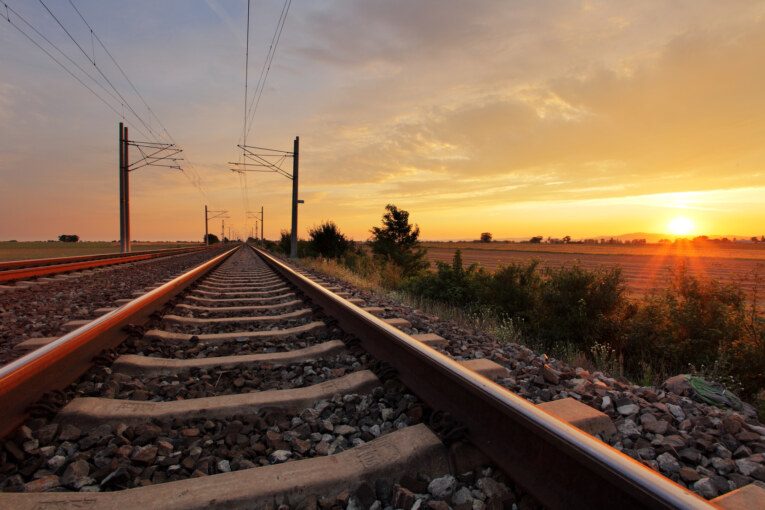
The construction of a new railway track can be divided into three stages.
- Earth Work
- Plate Laying
- Laying of Ballast
Earth Work
- The formation may be in an embankment or a cutting depending upon the general topography of the area.
- A formation in an embankment is normally preferred from the point of view of good drainage.
- The height of embankment above highest water in the area should be at least 60cm.
Plate Laying
- The operation of laying out of the rails and sleepers over the ready formation is known as plate laying.
- The point from where the laying of track starts is known as the base and the point upon which the new track is carried out is known as the rail head.
- Methods of plate laying:
- Tramline method or side method
- Telescopic method
- American method
Laying of Ballast
- The ballast is normally spread on the railway lines after the embankment has settled well and at least monsoons have passed over it.
- The work of spread the ballast is done by means of ballast trains, which have special hoopers through which the ballast can be automatically unloaded onto the track.
- Alternatively, ballast is loaded in wagons of the train and then unloaded at the site into a number of heaps at suitable intervals along the track.
- Then packing of ballast is done by the workers by means of shovels.
Track Drainage
- Track drainage can be defined as the interception, collection and disposal of water from, upon or under the track. It is accomplished by installing a proper surface drainage and sub-surface drainage system.
- Sources of water in a railway track.
- Surface water due to rain, dew, snow.
- Seepage water from adjacent area.
- Moisture sucked up by capillary action resulting in increase of moisture in the subgrade or embankment.
- Hygroscopic water or held water.
- Rain water surface.
Track Drainage System
- A good track drainage system shouls ensure that no water percolates into the track at either the surface or the sub-surface levels.
- The efficiency of a modern track depends upon the strength and stability of the formation which in turn depends upon the good track drainage.
- Track drainage should be handled in two distinctive phases:
- Surface Drainage
- Sub-surface Drainage
Surface Drainage
- Surface water due to rain, snow or from adjacent areas should be drained off properly by designing well-planned and effective surface drains.
- For bank and formation, good quality soil having well graded particles and high internal friction should be used. The soil should not swell or shrink with variation in moisture content.
- The surface water is first collected in well designed side drains and cross-drains which is further disposed off at the nearest stream or natural water course.
- Cross drainage structures like culverts and bridges may be necessary for disposing of the surface water.
Sand Piles
- Sand piles sand drains may be used for the removal of surface water from the embankment. In this method, holes of 30cm diameter and 1.8-3.0m deep are made between two rails and on the sides of the rails in the embankment. These holes are filled with coarse sand thus forming sand piles.
- Functions of sand piles are:
- To support the track.
- Sand Piles compact the soil and provide mechanical support to the subgrade just like wooden piles.
- The drainage of the subgrade also improves, as water rises to the surface through the sand piles by capillary action and evaporates.
Side drains
- Side drains should be provided along the track cutting and zero fill locations, where in the cess level is not above the ground level
- Side drain must have an adequate gradient and cross section to enable the free flow of collected water.
- All side drains should be provided with concrete lining.
Objectives of maintenance of railway track
- The strength of track structure goes on reducing due to high speed of heavy axle loads and repetition of loads.
- The track structure is subjected to other deteriorating effects like rain water, of sun and wind. The wear and tear of rails and rolling stock is bound to take place.
- The track structure has to bear so many other curvatures, speed and load particularly on curves, points and crossings.
Advantage of Good Maintenance
- The life of both track as well as of rolling stock increases.
- The journey becomes easy and comfortable.
- Increase in safety.
- Saving in operating costs as fuel consumption is less.
- Higher speed of trains is achieved.
Types of Maintenance
- Daily maintenance
- Periodical maintenance
Daily Maintenance
- Maintenance is carried out by the full time staff maintained throughout the year. The use of maintenance gangs, all along the railway track, is made. The railway track is divided into suitable sectons5-6km length.
- To check the rail gauge.
- To check the joints.
- To check the fittings of sleepers and rails.
Periodical Maintenance
- Periodic maintenance is carried out after an interval of two or three years.
- Levelling of rails
- Track alignment
- Gauge
- Proper Drainage Track Components
- Points and crossings


